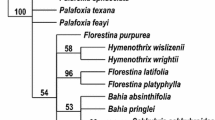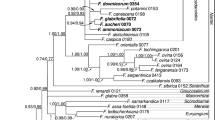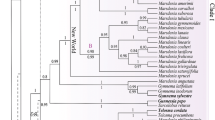Abstract
The familial placement of Wightia has long been a problem. Here, we present a comprehensive phylogenetic inspection of Wightia based on noncoding chloroplast loci (the rps16 intron and the trnL–F region) and nuclear ribosomal internal transcribed spacer, and on chemical analysis. A total of 70 samples (including 51 genera from 13 families of Lamiales) were employed in a molecular study. Phylograms suggest that Wightia is sister to Paulownia or Phrymaceae; species tree shows Wightia and Paulownia are sister groups which clustered with Phrymaceae in an unresolved clade. Chemical evidence shows affinity of Wightia to Paulowniaceae. With the addition of morphological, palynological and ecological characters, we suppose a familial position of Wightia belonging to or close to Paulowniaceae. Brandisia (a member of Orobanchaceae) does not have a close relationship with Wightia.





Similar content being viewed by others
References
Adriani C, Bonini C, Javarone C, Trogolo C (1981) Isolation and characterization of paulownioside, a new highly oxygenated iridoid glucoside from Paulownia tomentosa. J Nat Prod 44:739–744
Albach DC, Li HQ, Zhao N, Jensen SR (2007) Molecular systematics and phytochemistry of Rehmannia (Scrophulariaceae). Biochem Syst Ecol 35:293–300
Albach DC, Kun Y, Jensen SR, Li HQ (2009) Phylogenetic placement of Triaenophora (formerly Scrophulariaceae) with some implications for the phylogeny of Lamiales. Taxon 58(3):749–756
Argue CL (1980) Pollen morphology in the genus Mimulus (Scrophulariaceae) and its taxonomic significance. Am J Bot 67(1):68–87
Barker WR, Nesom GL, Beardsley PM, Fraga NS (2012) A taxonomic conspectus of Phrymaceae: a narrowed circumscriptions for Mimulus, new and resurrected genera, and new names and combinations. Phytoneuron 39:1–60
Bennett JR, Mathews S (2006) Phylogeny of the parasitic plant family Orobanchaceae inferred from phytochrome A. Am J Bot 93(7):1039–1051
Bentham G, Hooker JD (1876) Scrophulariaceae. In: Bentham G, Hooker JD (eds) Genera plantarum (vol 2). Williams and Norgaate, London, pp 913–980
Bremer B, Bremer K, Heidari N, Erixon P, Olmstead RG, Anderberg AA, Källersjö M, Barkhordarian E (2002) Phylogenetics of asteroids based on 3 coding and 3 non-coding chloroplast DNA markers and the utility of non-coding DNA at higher taxonomic levels. Mol Phylogent Evol 24(2):274–301
Burland TG (2000) DNASTAR’s Lasergene sequence analysis software. Methods Mol Biol 132:71–91
Campbell DH (1930) The relationships of Paulownia. Bull Torrey Botantic Club 57:47–50
Chadwell TB, Wagstaff SJ, Cantino PD (1992) Pollen morphology of Phryma and some putative relatives. Syst Bot 17(2):210–219
Damtoft S, Jensen SR (1993) Tomentoside and 7-hydroxytomentoside, two iridoid glucosides from Paulownia tomentosa. Phytochemistry 34(6):1636–1638
Doyle JJ (1987) A rapid DNA isolation procedure from small quantities of fresh leaf tissue. Phytochem Bull 19:11–15
Fischer E (2004) Scrophulariaceae. In: Kadereit JW (ed) The families and genera of flowering plants (vol 7). Springer, Berlin, pp 333–432
Gleason HA (1952) The new Britton and Brown illustrated flora of the northeastern United States and adjacent Canada (vol. 3). New York Botanical Garden, New York
Hallier H (1903) Ueber die abgrenzung und verwandtschaftdereinzelnensippenbei den Scrophularineen. Bull L’Herbier Boisser (ser. 2) 3:181–207
Hasegawa M, Kishino H, Yano T (1985) Dating of the human-ape splitting by a molecular clock of mitochondrial DNA. J Mol Evol 22(2):160–174
Hegnauer R, Kooiman P (1978) The taxonomic significance of iridoids of Tubiflorae sensu Wettstein. Planta Med 33:1–33
Heled J, Drummond AJ (2010) Bayesian inference of species trees from multilocus data. Mol Biol Evol 27:570–580
Hong DY, Yang HB, Jin CL, Holmgren NH (1998) Scrophulariaceae. In: Wu ZY, Raven PH (eds) Flora of China (vol 18). Science Press, Beijing, pp 1–212
Hu SY (1959) A monograph of the genus Paulownia. Q J Taiwan Mus 12:1–54
Jensen SR, Albach DC, Ohno T, Grayer RJ (2005) Veronica: iridoids and cornoside as chemosystematic markers. Biochem Syst Ecol 33:1031–1047
Jensen SR, Li HQ, Albach DC, Gotfredsen CH (2008) Phytochemistry and molecular systematics of Triaenophora rupestris and Oreosolen wattii (Scrophulariaceae). Phytochemistry 69:2162–2166
Lawrence GHM (1951) Taxonomy of vascular plants. Macmillan, New York
Li HL (1944) New or noteworthy plants from Southwestern China. J Arnold Arbor 25:316
Li HL (1947) Relationship and taxonomy of genus Brandisia. J Arnold Arbor 28:127–136
Liang ZY, Chen ZY (1995) An approach to the relationship of the genus Paulwnia and its related genera. J Huazhong Agric Univ 14(5):493–495 (in Chinese)
Maheshwari JK (1961) The Genus Wightia Wall. in India with a discussion on its systematic position. Bull Bot Surv India 3(1):31–35
McNeal JR, Bennett JR, Wolfe AD, Mathews S (2013) Phylogeny and origins of holoparasitism in Orobanchaceae. Am J Bot 100(5):971–983
Müller K, Borsch T, Legendre L, Porembski S, Theisen I, Barthlott W (2004) Evolution of carnivory in Lentibulariaceae and the Lamiales. Plant Biol 6(4):477–490
Nakai T (1949) Classes, ordinae, familiae, subfamilieae, tribus, genera nova quae attinent ad plantas Koreanas. J Jpn Bot 24:8–14
Nylander JAA (2004) MrModeltest v2.2. Program distributed by the author. Uppsala (Sweden): Evolutionary Biology Centre, Uppsala University
Olmstead RG, Depamphilis CW, Wolfe AD (2001) Distintegration of the Scrophulariaceae. Am J Bot 88(2):348–361
Oxelman B, Lidén M, Berglund D (1997) Chloroplast rps16 intronphylogeny of the tribe Sileneae (Caryophyllaceae). Plant Syst Evol 206:393–410
Oxelman B, Kornhall P, Olmstead RG, Bremer B (2005) Further disintegration of the Scrophulariaceae. Taxon 54:411–425
Ozaki Y, Johne S, Hesse M (1979) Natural organic substances. 174. Iridoid glucosides from Leucocarpus perfoliatus G. Don. Helv Chimica Acta 62:2708–2711
Park JM, Manen JF, Colwell AE, Schneeweiss GM (2008) A plastid gene phylogeny of the non-photosynthetic parasitic Orobanche (Orobanchaceae) and related genera. J Plant Res 121(4):365–376
Pennell FW (1920) Scrophulariaceae of the south-eastern United States. Proc Acad Nat Sci Phila 71:224–291
Posada D, Buckley TR (2004) Model selection and model averaging in phylogenetics: advantages of Akaike information criterion and Bayesian approaches over likelihood ratio tests. Syst Biol 53:793–808
Rahmanzadeh R, Müller K, Fischer E, Bartels D, Borsch T (2005) The Linderniaceae and Gratiolaceae are further lineages distinct from the Scrophulariaceae (Lamiales). Plant Biol 7(1):67–78
Ronquist F, Huelsenbeck JP (2003) MrBayes 3: bayesian phylogenetic inference under mixed models. Bioinformatics 19:1572–1574
Stöver BC, Müller KF (2010) TreeGraph 2: combining and visualizing evidence from different phylogenetic analyses. Bioinformatics 11:7
Swofford DL (2001) PAUP*: phylogenetic analysis using parsimony (* and other methods). Version 4.0b.10 for 32-bit Microsoft Windows. Sinauer, Sunderland
Taberlet P, Gielly L, Pautou G, Bouvet J (1991) Universal primers for amplification of three non-coding regions of chloroplast DNA. Plant Mol Biol 17:1105–1109
Tamura K, Peterson D, Peterson N, Stecher G, Nei M, Kumar S (2011) MEGA5: molecular evolutionary genetics analysis using maximum likelihood, evolutionary distance, and maximum parsimony methods. Mol Biol Evol 28:2731–2739
Umarova RU, Gorovits MB, Abubakirov NK (1988) Mussaenoside of Dodartia orientalis. Khim Prir Soedin 2:301–302
van Steenis CGGJ (1949) Notes on the genus Wightia (Scrophulariaceae). Bull Bot Gard Buitenzorg (ser. 3) 18:213–227
Venora G, Blangiforti S, Frediani M, Maggini F, Gelati MT, Castiglione MR, Cremonini R (2000) Nuclear DNA contents, rDNAs, chromatin organization, and karyotype evolution in Vicia sect. faba. Protoplasma 213:118–125
Wallich N (1830) Plantae Asiaticae Rariores (vol. 1). Treuttel and Würtz, London
Wei ZX (1989) Pollen morphology of Wightia and its taxonomic significance. Acta Bot Yunnanica 1:65–70 (in Chinese)
White TJ, Bruns T, Lee S, Taylor J (1990) Amplification and direct sequencing of fungal ribosomal RNA genes for phylogenetics. In: Innis MA, Gelfand DH, Sninsky JJ, White TJ (eds) PCR protocols: a guide to methods and applications. Academic Press, San Diego, pp 315–322
Willis JC (1955) A dictionary of the flowering plants and ferns. Cambridge University Press, Cambridge
Wolfe AD, Randle CP, Liu L, Steiner KE (2005) Phylogeny and biogeography of Orobanchaceae. Folia Geobot 40:115–134
Xia Z, Wang YZ, Smith JF (2009) Familial placement and relations of Rehmannia and Triaenophora (Scrophulariaceae s. l.) inferred from five gene regions. Am J Bot 96(2):519–530
Yan K, Zhao N, Li HQ (2007) Systematic relationships among Rehmannia (Scrophulariaceae) species. Acta Bot Boreali-Occidentalia Sinica 27:1112–1120 (in Chinese with English abstract)
Young ND, DePamphilis CW (2005) Rate variation in parasitic plants: correlated and uncorrelated patterns among plastid genes of different function. BioMed Center Evol Biol 5:16
Zwickl DJ (2006) Genetic algorithm approaches for the phylogenetic analysis of large biological sequence datasets under the maximum likelihood criterion. Ph.D. dissertation, University of Texas at Austin
Acknowledgments
We thank Jie Liu and Li–Na Dong (Kunming Institute of Botany, Chinese Academy of Sciences), You-Fang Wang, Ying-Ying Wang and Shen-Zhan Xiong (East China Normal University), and Zheng-Wei Wang and Bin-Jie Ge (Shanghai Chenshan Botanical Garden) for collecting specimens. We also thank the staff of the Royal Botanic Gardens Kew, England, for growing and providing the material of Hemichaena fruticosa. Our study was funded by the National Natural Science Foundation of China (Grant No. 31270242) and the Shanghai Natural Science Foundation (Grant No. 10ZR1408600).
Author information
Authors and Affiliations
Corresponding author
Electronic supplementary material
Below is the link to the electronic supplementary material.
Rights and permissions
About this article
Cite this article
Zhou, QM., Jensen, S.R., Liu, GL. et al. Familial placement of Wightia (Lamiales). Plant Syst Evol 300, 2009–2017 (2014). https://doi.org/10.1007/s00606-014-1029-5
Received:
Accepted:
Published:
Issue Date:
DOI: https://doi.org/10.1007/s00606-014-1029-5




